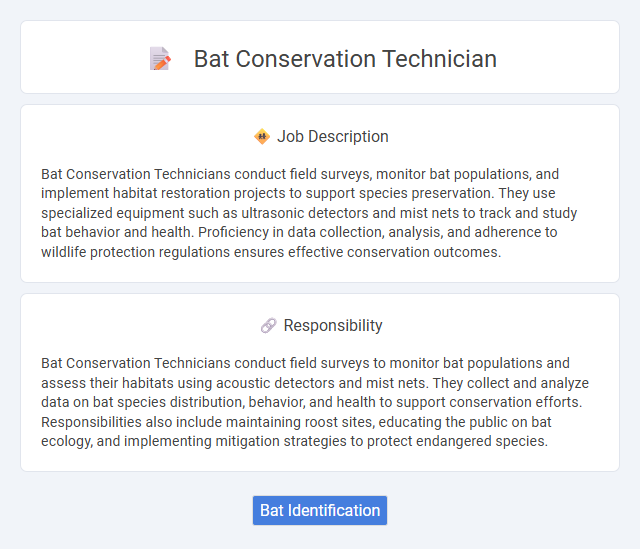
Bat Conservation Technicians conduct field surveys, monitor bat populations, and implement habitat restoration projects to support species preservation. They use specialized equipment such as ultrasonic detectors and mist nets to track and study bat behavior and health. Proficiency in data collection, analysis, and adherence to wildlife protection regulations ensures effective conservation outcomes.
Individuals with a strong passion for wildlife and outdoor activities are likely well-suited for a Bat Conservation Technician role, which often involves nocturnal fieldwork and physical endurance. Candidates who are comfortable working in diverse weather conditions and possess an interest in ecological research may find this job especially rewarding. Those with allergies to bats or who prefer indoor work environments may have a lower probability of thriving in this position.
Qualification
A Bat Conservation Technician typically requires a background in wildlife biology, ecology, or environmental science, often supported by a bachelor's degree in these fields. Key qualifications include experience with field surveys, bat species identification, and data collection using ultrasonic detectors and GPS technology. Proficiency in handling wildlife safely, knowledge of relevant conservation laws, and skills in database management and report writing are essential for effective monitoring and conservation efforts.
Responsibility
Bat Conservation Technicians conduct field surveys to monitor bat populations and assess their habitats using acoustic detectors and mist nets. They collect and analyze data on bat species distribution, behavior, and health to support conservation efforts. Responsibilities also include maintaining roost sites, educating the public on bat ecology, and implementing mitigation strategies to protect endangered species.
Benefit
Working as a Bat Conservation Technician likely offers benefits such as gaining hands-on experience in wildlife management and habitat restoration, which may enhance career prospects in ecology and conservation fields. The role probably provides opportunities to contribute to the protection of vulnerable bat populations, potentially increasing job satisfaction through meaningful environmental impact. Exposure to fieldwork and data collection techniques may also improve technical skills, benefiting future employment or academic pursuits.
Challenge
Bat Conservation Technician roles likely present challenges involving nighttime fieldwork in diverse environments, requiring adaptability to varying weather and terrain conditions. Technicians probably face difficulties in accurately monitoring bat populations due to elusive behavior and the need for specialized equipment like ultrasonic detectors. The job might also demand balancing physical endurance with meticulous data collection to support effective conservation efforts.
Career Advancement
Bat Conservation Technicians gain specialized expertise in wildlife monitoring, habitat restoration, and species protection, providing a strong foundation for career advancement in environmental science and ecology. Opportunities for progression include roles such as Wildlife Biologist, Conservation Manager, or Environmental Consultant, leveraging field experience and technical skills. Professional development through certifications and advanced degrees enhances prospects for leadership positions in governmental agencies and non-profit conservation organizations.
Key Terms
Bat Identification
Bat Conservation Technicians specialize in bat identification through acoustic monitoring and physical surveys, utilizing ultrasonic detectors and DNA analysis to accurately differentiate species. Proficiency in recognizing echolocation call patterns and habitat preferences is essential for effective population assessments and conservation strategies. Expertise in data collection supports efforts to mitigate threats from habitat loss and disease such as White-nose Syndrome.
 kuljobs.com
kuljobs.com